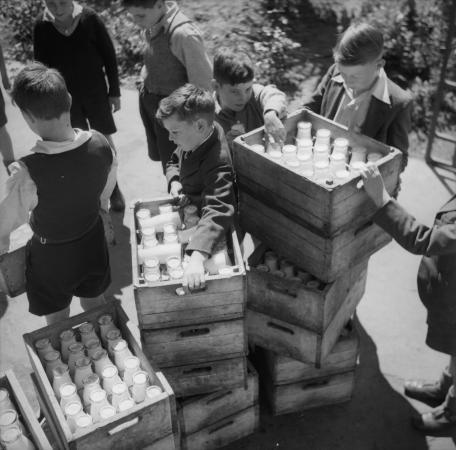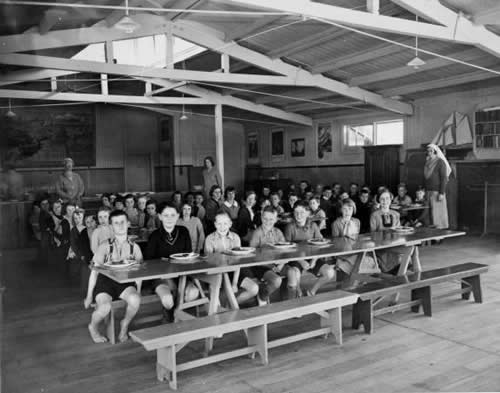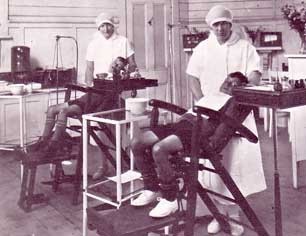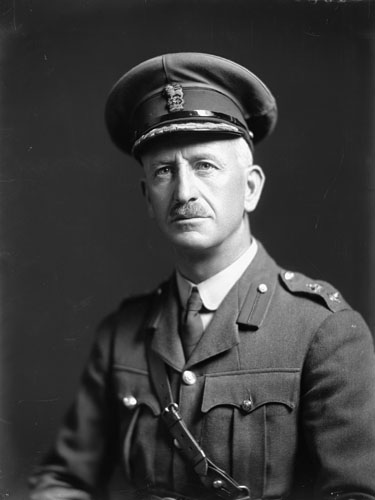An example of Corrective Action within the Armed Forces in the 1930’s and the wider ramifications of such a change within Civil Society
As we have seen, there were numerous problems with Conscript Service in the 1920’s. We will look at these in broad detail in a subsequent post. For now, we will content ourselves with looking at one specific issue, how corrective action within the Armed Forces ensured that this was addressed, the wider ramifications of this corrective action within Civil Society and an unexpected consequence of this particular action when the Winter War broke out.

School Children distributing Free School Milk
A specific problem that was addressed was malnutrition. In the 1920’s in particular, many of the recruits came from such poor families and lived in such poor conditions that they were malnourished. A combination of military-initiated programs were instituted to address this problem. One of the first programs outside of the military was the introduction of free school breakfasts and lunches and free school milk from 1932 on.
In this way, children from poorer families received at least two good solid meals a day. (It is perhaps worth mentioning that while this program was initiated by the military, it was organized and run by the Lotta Svärd organisation with food and milk funded from the Education budget). This single initiative by itself won a tremendous amount of goodwill for the Army, not so much from the Left as from the poorer elements of society whose children benefited. The senior leadership of the Army, Suojeluskuntas and Lotta Svärd who jointly promoted this initiative received much favorable press.

….and School Meals
On entry into the military, a physical assessment of recruits was carried out as they began their service and recruits who appeared malnourished were, from 1932 on, put on special diets to build them up. In addition, the military dental care program was initiated – some 60% of recruits at this time had major problems with their teeth due to their poor diets and/or poor dental hygiene – and from 1933 on this was addressed as recruits began their service with the military dental care program (the introduction of the school dental care program in 1935 was another byproduct of this military initiative and one that will be described in more detail below – reports on the poor condition of so many recruits teeth eventually reached all the way up to Mannerheim, who followed through by urgingg the Government to put in place a comprehensive school dental care program as one of his many initiatives related to child welfare. This was initiated in 1935, with School Dental Clinics staffed by trained “Dental Nurses” – in many remote rural areas, the School Dental Clinics were in fact the only dental care available and their role was more often than not informally extended to include dental care for adults.

1937 – Finnish School Dental Nurses and the “Victims”
The Finnish School Dental Service was not a world-first – the service as it was instituted in Finland was modeled on that of New Zealand, which in the 1920’s had been the first in the world to set up such a program – but it was a first within Scandanavia. The service as introduced aimed to provide preventive dental care to school children from clinics located on school grounds. Rather than take the children to the dentist (impractical in many areas of Finland), the dentist was brought to the children.
A dental school to train these dental nurses was opened in Helsinki in 1935. The immediate popularity of the program lead the Government to rapidly expand the service, with additional training schools being opened in Tampere in 1937 and Vipurii in 1939. Large numbers of dental nurses were rapidly trained and the school dental nurse in her “whites” and red cardigan and her clinic (which rapidly became known as “the murder clinic” to generations of children) quickly became a part of the school community, though children tended to tread rather warily when in the vicinity of the clinic lest they be summoned inside for one of their twice yearly check-ups.
The Finnish system was very closely modeled on the New Zealand system (and in fact was assisted in getting started by the official participation of a small number of New Zealand Health Department officials who had been instrumental in setting up the New Zealand system, led by Colonel Thomas Anderson Hunter, who had been head of the New Zealand Army Dental Corps in WW1, and who was also the Director of the Division of Dental Hygiene within the New Zealand Department of Health until his retirement in 1930 and largely responsible for the New Zealand Dental Nurse program).

Colonel Thomas Anderson Hunter, originator of the New Zealand School Dental Service in the 1920’s and Advisor to the Finnish Government on setting up a similar program in Finland in the 1930’s
Colonel Hunter had, before WW1, been Chairman of the NZ Dental Association, during WW1 he had been commanding officer of the New Zealand Army Dental Corps and he was a man with many political, official and military contacts within New Zealand. When the Finnish Government, via their Embassy in London, had contacted the New Zealand High Commission in London and requested an expert to assist in setting up a similar program, Colonel Hunter (then retired) had volunteered his assistance.
With the agreement of both governments, he had come out of retirement and traveled to Helsinki with his wife, Greta, in 1934. Similarly to the New Zealand system, the plan he drafted for the Finnish service proposed training and sending women into schools to do basic dental work and educate children and parents on tooth care and healthy living. He argued that women were better suited than men to working with children, and such a scheme would be far cheaper than training more dentists. He also supported his plan with the justification that dental nursing would provide short term employment between young women leaving school and getting married and starting families. As in New Zealand, his proposal was in large part accepted because the cheapness of the scheme and it’s instant popularity appealed to politicians in a period when government resources were stretched.
As a sidenote, Colonel Hunter was still in Helsinki and working in the Finnish School Dental Service when the Winter War broke out in late 1939. Despite his age, he volunteered to assist the Suomen Maavoimat and served in the Dental Corps of the Finnish Army for the duration of the Winter War. He was also instrumental in leveraging his high-level contacts within the New Zealand Government and Military and the New Zealand High Commission in London to secure assistance for Finland from New Zealand and Australia. Given the distance of these countries from Finland, this was somewhat limited, but despite this, Colonel Hunter was instrumental in engineering the arrival of a single Battalion of ANZAC (Australia and New Zealand) volunteers recruited primarily from Australians and New Zealanders together with some South Africans and Rhodesians living in the UK at the time. Only volunteers with previous military experience were accepted (their experience was largely from the Territorial Army’s in their respective countries), they were given some hasty refresher training before being transported via Finnish-flagged passenger ship to Norway and thence to Finland, arriving in January 1940. The story of these ANZAC volunteers together with other foreign volunteers who arrived to assist Finland will be covered in more detail in a later post or posts.
The School Dental Care Program was no statist experiment in the compulsory torture of the young: parental permission was sought and widely given. By 1940, more than 60 percent of preschool children and 95 percent of primary school children were voluntarily registered (by their parents!) with the school dental service, underscoring the high participation rate by the community. Significant improvements in dental health were registered over the longer term. For instance, in 1935 there were 78.6 teeth requiring extraction for every 100 teeth that were restored. By 1945 this figure was reduced to 2.5 extractions per 100 restorations. Thus, by 1945 many young-adult Finns retained a full set of teeth, many with few fillings, in strong contrast to the period up to 1935 when many of the same age cohort had lost many or even all their teeth by sometime in their twenties or thirties.
The School Dental Nurses themselves saw the benefits of their work, even though many of them initially entered the field largely because it was one of the few occupations open to women. Lieksa’s Ilmi Pentikäinen got into school dental nursing by chance. Having finished her last year at school, she had moved to Tampere and was working in a factory when “I saw the advertisement in the paper, it said ‘Only two exams’, and I thought “Well! That will do me!’ and because I really didn’t want to keep working in a factory I applied and got in. Of course when I went down there to Helsinki, there were all sorts of tests and I really was lucky to be selected!” That was in 1935, when 18-year-old Ilmi Pentikäinen was looking for a career a little different to the norm. Dental nursing seemed right for her. “It was very selective. There weren’t many careers for women in those days – nurses, teachers, and if you were very bright and your family could afford it you went off to university, or else it was working in factories or shops or you stayed on the farm until you got married, which was what most of my friends did. There just wasn’t that much choice for girls in those days.”
>The school dental service had been set up as an experiment in public health after a strong recommendation from the military and at the insistent urging of Mannerheim, who was concerned with the impact of poor dental care on Army conscripts. (As mentioned earlier_, the initial program was based on the New Zealand model (in 1921, New Zealand had been the first country in the world to set up a school dental program – a first in public health at the time). Also closely modeled on the New Zealand system, the Finnish Service’s aim was to send women into schools to do basic dental work and educate children and parents on tooth care and healthy living. Hundreds applied, but in 1935 Ilmi was one of only 120 girls chosen from over 2,000 applicants to train in the first intake of dental nurses. The dental nurses started their two-year training at an old building newly converted to the task in Helsinki. “It was lovely there. We started off as a junior nurse with a blue veil – we were more or less the flushies – we cleaned the head rests and basins and set up the tables and sterilised the equipment for the senior nurses as well as attending lectures”.
The young dental nurses learnt the ‘ins and outs’ of teeth by carving plaster cast moulds of the jaw, studying from the incisors to the molars. The next step was creating ‘dummy jaws’ inserting human teeth into plaster cast moulds to practice drilling on. “We used teeth dentists had extracted. I remember going around Helsinki on the tram collecting all these gory teeth in a jar! We’d have to clean them up before we could use them.” The students had to pass tests before they could move onto real live patients – who were the children from surrounding schools. “You had to build a rapport with the kids, chat away with them, reassure them.” Back in those days the dental nurses had treadle machines to drill teeth. Pumping their feet on the treadle would turn the drill bit in the patient’s tooth. “Most of us had worked on treadle sewing machines, so we were used to it. You learnt the rhythm to keep the drill going.” Unlike today, patients didn’t receive a pain-numbing injection before they had their teeth drilled. “We only gave injections for a tooth extraction. You just put up with the pain of having a cavity drilled – it wasn’t for long. Of course, sometimes the kids tried to run away, and then you had to team up, with one holding them in the chair and the other doing the drilling.”
The students learnt how to heat little copper pellets in a spoon over a Bunsen burner until they melted. “We’d then screw it up in a piece of gauze so the mercury would come out on our hands.” The copper fillings were a cheaper filling used on children’s baby teeth. “We’d put the mercury in a little bottle as a special treat for the kids – we called them Silver Fairies – as a play thing. Of course today that would be frowned on!” For fillings in permanent teeth the dental nurses would weigh out silver amalgam and mercury on little scales before mixing them together in a mortar and pestle. “We thought nothing of handling the mercury with our bare hands – we didn’t know any different.”
Ilmi graduated from training school and went to work as a sole-charge dental nurse in a small town in Eastern Karelia in January 1937. Her job was to travel to outlying schools, checking children’s teeth and arranging for them to see her at the central dental clinic at the school in town if they needed treatment. She was expected to treat 500 children every six months. “It was a big challenge. I spent a lot of time on the phone asking the central clinic in Helsinki how to do things!” But her training had drummed into her the basics of tooth repair. “The cavity you made with the drill, the lining you put in, then the filling…” She says, mostly, children were very well behaved when they visited the dental clinic. “I think it was a lot to do with how I treated them. I only struck one unmanageable child. He just was not going to co-operate. So I just sent him back to class. He came back on his own a few weeks later because his tooth hurt so badly. By then I had to extract it.” In 1939, Ilmi was assigned to operate from a mobile dental clinic that was towed from school-to-school in the very remote areas near the border. “It was a good place for a young dental nurse. Schools and parents were very welcoming, and even children seemed to like the new dental nurse. It was interesting going around all those schools … The mobile clinic was very good. Some dental nurses had to work on school stages, and in school halls, in corridors… those poor girls. These days they wouldn’t be allowed to – it wasn’t sterile enough – but they coped.”
As a trainee dental nurse, Ilmi had joined the Lotta Svärd organisation when she started training. “It was what you were expected to do. The Lotta Svärd did all sorts of things, and it was just accepted that we all would join. Nobody ever questioned that, it was just something one did without even being asked. Some of the girls didn’t like the military training part of it but personally, I really enjoyed it.” She was mobilized when the Winter War broke out and assigned to an Army Dental Unit. “We were behind the front-lines, but close enough that we could almost always hear the guns. Even when we were working, we had to have our guns nearby in the Clinic in case we were attacked. It never happened to me, but I heard some of the girls had to use theirs. And we got to do all sorts of dental work that we weren’t allowed to do at the school clinics. The Dentist in charge..”(there was usually one Dentist working with a team of Dental Nurses under him) ..”trained us to do all sorts of procedures. But we weren’t allowed to use them on the children, it was just because of the war and it was all urgent.” Ilmi went back to school dental work after the Peace Treaty but was mobilized again when Germany attacked the USSR. She was told that with her experience she was mobilized for the duration, meaning she couldn’t leave unless she had a very good reason. That reason came after her first child was due in 1944 (she married in 1941 – “I was doing a filling for a Suojeluskunta Officer, he was a Captain when I met him I think, on a Lotta Svärd weekend and he asked me out, I said yes because he had such nice teeth, usually I turned them down right away”) and she was released from service. Like all the other dental nurses from that period, she thought “We did work that really had value. Before we came, none of those children or their parents ever saw a dentist, most of them didn’t even know how to clean their teeth. It still amazes me that Mannerheim paid attention to all these details – he was such a busy man with so many responsibilities on his shoulders but still he made enough time to push through things like this!”
Note that this is just one small example of the widespread ramifications on Finnish Society of the changes to Conscript Military Service that were made through the 1930’s. One small change (dental work on the teeth of Conscripts) led to a School Dental Program which in turn led, after the Winter War broke out) to a Battalion of ANZAC volunteers arriving in January 1940. The Butterfly Effect exemplified.
Return to Table of Contents for “Punainen myrsky – valkoinen kuolema” (Red Storm, White Death)
 Copyright secured by Digiprove © 2013 Alternative Finland
Copyright secured by Digiprove © 2013 Alternative Finland


